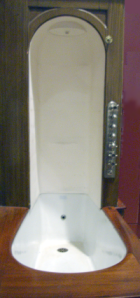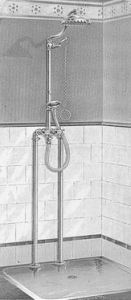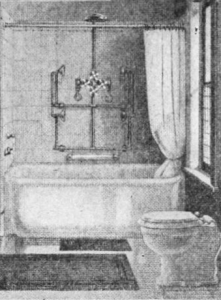
The earliest showers were rather like having a pail of water tipped over you from a height. By the 1880s there were some more sophisticated contraptions available. They could be fully integrated with indoor plumbing, and came complete with an array of taps and valves to adjust temperature, water flow, and more. Patent mixers were invented to make sure the water could never be scalding hot. One manufacturer promised their needle shower would not let water go over 98 degrees F (body temperature). Showers were supposed to be invigorating and health-giving, so cool or lukewarm water was considered beneficial.
- A needle bath or needle shower directed jets of water all round the torso. Sometimes the water flow could be adjusted, and a particular setting was promoted as a liver shower or bath, supposedly offering a stimulating massage for internal organs. Its energising effects were considered more suitable for men than women. Needle showers were marketed to gentlemen’s athletic clubs as well as private houses. Some people call them cage showers.
- A rain bath or shower was an overhead spray coming from a circular head pointing straight down or slightly slanted. Also called a spray bath, it was a desirable fitting for modern, hygienic public baths and hospitals.
- Combination showers with a variety of features were promoted by leading manufacturers. Some were decorative as well as cleverly designed. They led to the canopy shower.

- Canopy showers or canopy baths built several bathing features into a fine piece of furniture. Designed for bathrooms in well-decorated homes, these were available for the well-heeled buyer in North America and Europe in the late 1800s and early 1900s. The porcelain enamel tub extended upward at one end into a tall curved shower wall, usually with a hood. This impressive bathroom centrepiece could be seven feet high. Many were fitted inside dark polished wood cases; some had ornamental enamelled metal exteriors. Douche and plunge settings were sometimes included. The plunge was a gushing flow of water, not a spray or fine jets. Other features of needle or canopy baths could include a kidney, spinal, or bidet spray, or a special shampoo spray.

UK manufacturers tried to entice wealthy late Victorian customers with a steady supply of new features. As well as all the shower options, you could have fine carving on the canopy bath surround, a curving bath with extra space at the shower end, or an open top “Oriental” bath which avoided any “sense of confinement”. Instead of being enclosed in dark wood, the Oriental model was metal decorated with stencilled friezes, fluted columns, and cornices. Copper and other metal canopies came into vogue, and started to replace the heavy mahogany look.
When did ordinary homes get showers?
Around 1900 these were splendid luxuries for rich people, who often bought them for the supposed health benefits of special kinds of bathing. A lot of routine hygiene depended on washstands and hip baths in the bedroom. But when were showers fitted in middle-class homes? There are plenty of statistics about the percentage of homes in various countries with either a bath or a shower, but very little about showers alone.
The 1920s was when showers began to spread to “normal” homes in the USA, especially new homes, according to many writers.† The pictures at the bottom of the page give a foretaste of this, with US bathroom designers illustrating not-too-lavish bathrooms with showers included. Sears Roebuck was selling showers by 1915. By 1965 a study of one thousand American middle-class homes found that 85% had both a tub and a shower.*

Even though British shower manufacturers and wealthy customers had kept pace with American developments up to WWI, it stopped there. Bathrooms were different on different sides of the Atlantic. Showers appeared in sports clubs and other communal facilities but remained uncommon in private homes in Britain before the 1970s/80s. (Sorry, only anecdotal evidence so far, but I’m pretty sure.)
Many European countries were far slower than the USA to adopt showering at home. Possible reasons include older housing stock without space for showers, and progressive attitudes to new technology in America. Attitudes to hygiene varied from culture to culture. Sweden was one of the first European countries to take home showers to its heart. 1980s studies in Sweden and Minnesota showed that in both places most homes had a shower and a bathtub.‡
Photos
Photographers credited in captions. Links to originals here:
American needle shower, shower controls.
More picture info here
Notes
†For example, Old House Magazine, Nov 1994
*Marilyn Langford, Personal hygiene attitudes and practices in 1000 middleclass households, Cornell University, 1965
‡Rita J. Erickson, Paper or plastic?: energy, environment, and consumerism in Sweden and America, 1997
Also see:
Katherine Ashenburg, The Dirt on Clean: An Unsanitized History
David Eveleigh, Bogs, Baths, and Basins: The Story of Domestic Sanitation
Porcelain and enamel are two different names for the same glazed coating on iron baths: usually white but not always.



Appreciation to my father who stated to me on the topic of this webpage, this website is in fact
awesome.
LikeLike
that’s cool, dude
LikeLike
this is awsome
LikeLike
this is so cool and the best
LikeLike
This is amazing.
LikeLike
Tomo Friendsgiving and I’m wondering about this. Hello 2020.
LikeLike
I have one for sale if anyone wants it. $8000 U.S.
LikeLike